Introduction
AWeber vs Mailchimp: Discover the key differences between these two popular email marketing platforms in our detailed comparison. Learn about their features, pricing, ease of use, and more to find the best tool for your needs. If you’re trying to decide between AWeber vs Mailchimp for your email marketing efforts, you’re not alone. Both platforms are widely used but cater to different requirements and preferences. In this blog post, we’ll compare AWeber and Mailchimp across essential areas such as features, pricing, and user experience. Whether you’re a small business owner or part of a larger organization, this guide will help you determine which platform aligns best with your email marketing strategy.
Table of Contents
Features and Functionality: AWeber vs Mailchimp
When comparing AWeber vs Mailchimp, understanding their features and functionality is crucial for selecting the best email marketing tool for your needs. Here’s a concise breakdown:
1. Email Templates and Design Options
- Mailchimp: Offers a wide range of customizable email templates and a user-friendly drag-and-drop editor. It also includes a content studio for easy access to your assets.
- AWeber: Provides a robust selection of email templates and a similar drag-and-drop editor. It also features a library of pre-written email sequences tailored to various industries.
2. Automation and Workflow Capabilities
- Mailchimp: Known for its advanced automation features, including automated workflows, triggered emails, and a comprehensive journey builder that allows for complex sequences.

- AWeber: Offers automation with an easy-to-use visual automation builder. It supports trigger-based emails and autoresponders, but is generally less complex than Mailchimp’s offerings.

3. List Management and Segmentation
- Mailchimp: Excels in list management with robust segmentation options and advanced analytics. It allows for detailed audience tagging and segmentation based on user behavior.
- AWeber: Provides solid list management features with basic segmentation and tagging. It’s user-friendly, but not as advanced as Mailchimp’s segmentation capabilities.
Overall, both AWeber and Mailchimp offer strong features for email marketing, but your choice may depend on whether you need more advanced automation and segmentation capabilities (Mailchimp) or a straightforward, user-friendly interface (AWeber).
Pricing and Plans: AWeber vs Mailchimp
When evaluating AWeber vs Mailchimp, pricing and plans are essential factors to consider. Here’s a concise comparison:
1. Cost Comparison
- Mailchimp: Offers a free tier for up to 500 subscribers and 1,000 emails per month. Paid plans start at $13 per month for the Essentials plan, which includes additional features like advanced reporting and A/B testing. Higher-tier plans, such as Standard and Premium, offer more advanced features and start at $20 and $350 per month, respectively.

- AWeber: Does not offer a free tier, but provides a 30-day free trial. Paid plans start at $20 per month for up to 500 subscribers. Pricing increases based on the number of subscribers, with plans reaching up to $150 per month for 25,000 subscribers.
2. Value for Money
- Mailchimp: Offers a variety of features even in lower-tier plans, such as basic automation, analytics, and customer support. Higher-tier plans provide access to more advanced tools and higher limits.
- AWeber: Provides strong value with features like unlimited email sends and customer support in all plans. Its pricing is straightforward, but it can become more expensive as your subscriber list grows.
Ease of Use: AWeber vs Mailchimp
When choosing between AWeber vs Mailchimp, ease of use is a critical factor. Here’s a concise comparison:
1. User Interface
- Mailchimp: Features a modern, intuitive interface that is easy for beginners to navigate. The dashboard is well-organized, with a clear layout for accessing campaigns, reports, and audience insights.
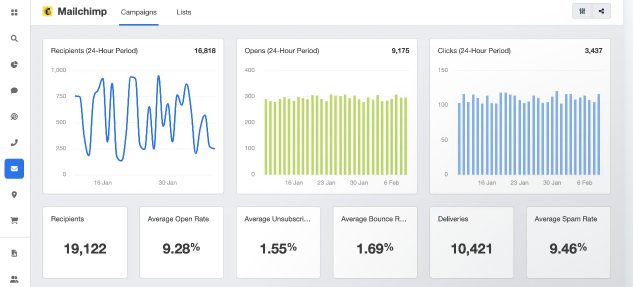
- AWeber: Offers a straightforward interface that is simple to use. The layout is clean, but some users may find it less visually engaging compared to Mailchimp.
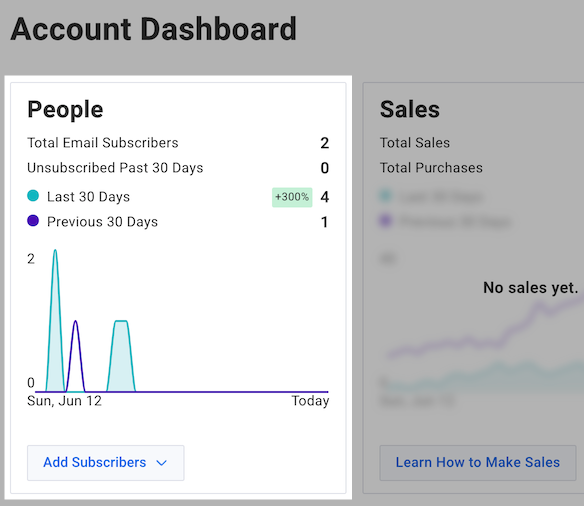
2. Learning Curve
- Mailchimp: Provides extensive tutorials, guides, and a robust knowledge base, making it easy for users to learn and utilize its features effectively. The drag-and-drop editor is user-friendly, even for those new to email marketing.

- AWeber: Also offers a variety of educational resources, including video tutorials and customer support. The drag-and-drop editor is straightforward, and users generally find the learning curve manageable.
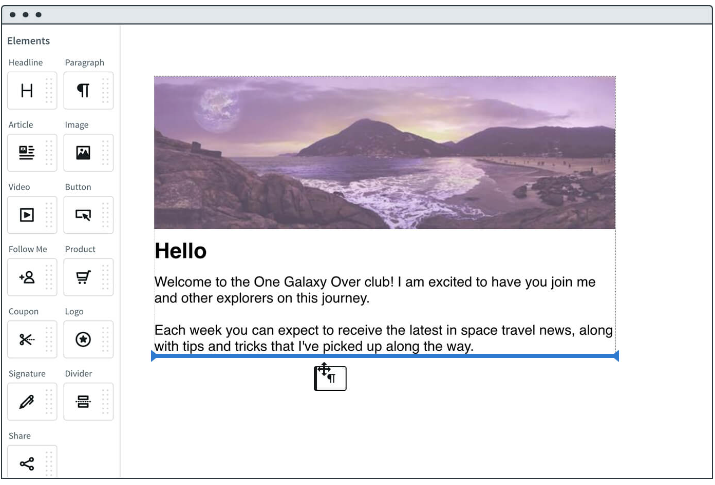
Integration Options: AWeber vs Mailchimp
When evaluating AWeber vs Mailchimp, the range of integration options can significantly impact your choice. Here’s a brief comparison:
1. Third-Party App Integrations
- Mailchimp: Supports a wide array of third-party integrations, including popular platforms like Shopify, WooCommerce, and Zapier. This extensive range allows for seamless connectivity with various apps and services.
- AWeber: Offers a good selection of integrations, including platforms such as WordPress, PayPal, and Facebook. While it covers many essential tools, it has fewer options compared to Mailchimp’s extensive list.
2. E-Commerce and CRM Integrations
- Mailchimp: Provides robust e-commerce integrations with tools like Magento and BigCommerce, and CRM integrations with Salesforce and HubSpot. These integrations enable effective syncing of customer data and streamlined marketing efforts.

- AWeber: Integrates well with e-commerce platforms such as Etsy and WooCommerce, and offers CRM connections with tools like Salesforce. However, it has fewer high-profile CRM integrations compared to Mailchimp.
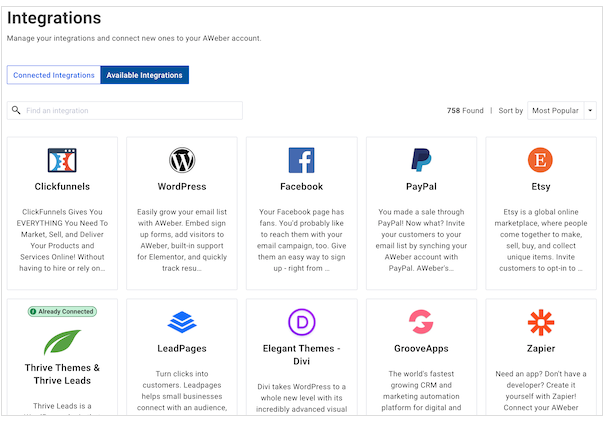
Deliverability and Performance: AWeber vs Mailchimp
When comparing AWeber vs Mailchimp, deliverability and performance are critical factors for ensuring your emails reach your audience effectively. Here’s a concise overview:
1. Email Deliverability Rates
- Mailchimp: Generally boasts high deliverability rates, attributed to its strong reputation and advanced deliverability tools. It provides features like dedicated IP addresses and deliverability insights to help maintain a high inbox placement rate.
- AWeber: Also maintains good deliverability rates and offers features such as list cleaning and spam filter testing. It provides similar tools to help optimize your email performance and ensure your messages land in the inbox.
2. Reporting and Analytics
- Mailchimp: Offers comprehensive reporting tools with detailed analytics on open rates, click rates, bounce rates, and more. Its performance dashboard provides in-depth insights to optimize future campaigns.

- AWeber: Provides robust reporting and analytics, including metrics on open rates, click rates, and campaign performance. The reporting tools are user-friendly and effective for tracking email success.

3. Performance Optimization Features
- Mailchimp: Includes advanced tools such as A/B testing, predictive analytics, and engagement tracking to enhance email performance. These features help tailor your campaigns for better results.
- AWeber: Offers solid performance optimization tools like split testing and detailed performance metrics. While effective, its features are slightly less advanced compared to Mailchimp’s offerings.
Customer Support: AWeber vs Mailchimp
When comparing AWeber vs Mailchimp, customer support is an essential aspect to consider. Here’s a brief comparison:
1. Support Channels
- Mailchimp: Offers email support and live chat for paid plans. The free plan provides access to a knowledge base and community forums, but no direct support. The paid plans offer priority support with faster response times.
- AWeber: Provides phone, email, and live chat support across all plans. Their support is accessible and known for being responsive, which is beneficial for resolving issues promptly.
2. Quality and Responsiveness
- Mailchimp: Known for providing thorough and helpful support through its paid plans, with detailed responses and solutions. The quality of support can vary based on the plan level.

- AWeber: Generally praised for its excellent customer service, with quick response times and knowledgeable support staff. All users, regardless of plan, receive the same level of support.
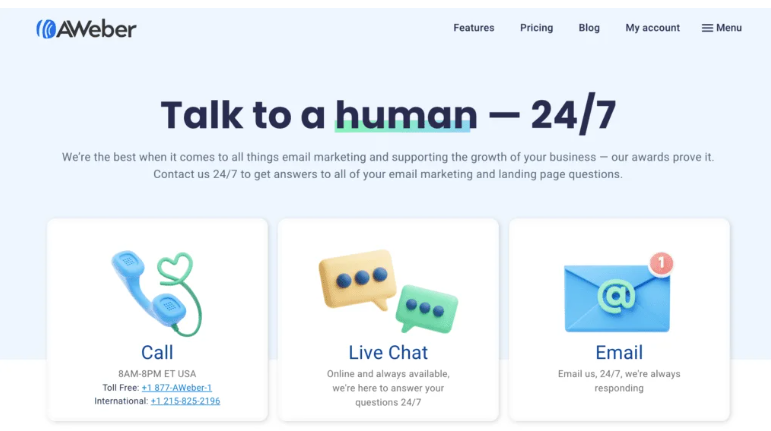
Scalability and Growth Potential: AWeber vs Mailchimp
When assessing AWeber vs Mailchimp, scalability and growth potential are important factors to consider for long-term success. Here’s a concise overview:
1. Suitability for Small to Large Businesses
- Mailchimp: Highly scalable, making it suitable for both small businesses and large enterprises. It offers a range of plans and features that grow with your business, including advanced tools for complex marketing needs.
- AWeber: Also supports scalability, but is generally favored by small to medium-sized businesses. It provides essential tools for growing businesses, though it may lack some of the advanced features required by very large organizations.
2. Flexibility in Plan Upgrades
- Mailchimp: Provides flexible plan upgrades that align with business growth, allowing you to scale up as needed. Higher-tier plans offer more features and capacity, accommodating increasing demands.
- AWeber: Also allows for plan upgrades, with clear pricing tiers that reflect additional features and subscriber limits. It’s straightforward but may not offer as many advanced features as Mailchimp’s higher-tier plans.
User Reviews and Reputation: AWeber vs Mailchimp
When evaluating AWeber vs Mailchimp, user reviews and reputation provide valuable insights into each platform’s performance and reliability. Here’s a concise comparison:
1. Overall User Satisfaction
- Mailchimp: Generally receives positive feedback for its user-friendly interface, extensive features, and flexibility. Users appreciate its advanced automation and integrations, though some criticize its pricing structure and customer support, particularly for free-tier users.

- AWeber: Known for its excellent customer support and ease of use. Users frequently highlight its responsive support team and straightforward tools. However, some reviews point out that its features are less advanced compared to competitors like Mailchimp.

2. Reputation in the Industry
- Mailchimp: Has a strong reputation as a leading email marketing tool, widely recognized for its comprehensive feature set and innovation. It is often recommended for its scalability and advanced capabilities.
- AWeber: Maintains a solid reputation, particularly for its customer service and simplicity. It is well-regarded among small to medium-sized businesses and has a loyal user base.
Conclusion
When choosing between AWeber vs Mailchimp, your decision will largely depend on your specific needs and preferences. Mailchimp stands out for its extensive features, advanced automation, and scalability, making it a strong choice for larger businesses and those requiring sophisticated tools. On the other hand, AWeber offers excellent customer support, a straightforward interface, and reliable performance, ideal for small to medium-sized businesses seeking simplicity and responsive service.
Both platforms have their strengths, so consider what matters most to your email marketing strategy—whether it’s advanced features and integrations or ease of use and customer support. By evaluating these factors, you can select the tool that best aligns with your goals and helps drive your email marketing success.





